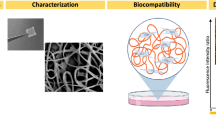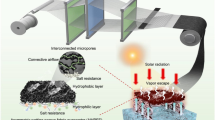Abstract
The evolution of hemodialysis membranes (dialyzer, artificial kidney) was remarkable, since Dow Chemical began manufacturing hollow fiber hemodialyzers in 1968, especially because it involved industrial chemistry, including polymer synthesis and membrane manufacturing process. The development of hemodialysis membranes has brought about the field of medical devices as a major industry. In addition to conventional electron microscopy, scanning probe microscopy (SPM), represented by atomic force microscopy (AFM), has been used in membrane science research on porous membranes for hemodialysis, and membrane science contributes greatly to the hemodialyzer industry. Practical studies of membrane porous structure–function relationship have evolved, and methods for analyzing membrane cross-sectional morphology were developed, such as the ion milling method, which was capable of cutting membrane cross sections on the order of molecular size to obtain smooth surface structures. Recently, following the global pandemic of SARS-CoV-2 infection, many studies on new membranes for extracorporeal membrane oxygenator have been promptly reported, which also utilize membrane science researches. Membrane science is playing a prominent role in membrane-based technologies such as separation and fabrication, for hemodialysis, membrane oxygenator, lithium ion battery separators, lithium recycling, and seawater desalination. These practical studies contribute to the global medical devices industry.


Similar content being viewed by others
Data availability
The data that support the findings of this study are available.
References
Hiyoshi T. Is there a limit to the spinning processes of dialysis membranes? (in Japanese). Jin to Touseki. 1996;96:26–30.
Nunes SP, Culfaz-Emecen PZ, Ramon GZ, Visser T, Koops GH, Jin W, Ulbricht M. Thinking the future of membranes: perspectives for advanced and new membrane materials and manufacturing processes. J Membr Sci. 2020;598:117761. https://doi.org/10.1016/j.memsci.2019.117761.
Duy Nguyen BT, Nguyen Thi HY, Nguyen Thi BP, Kang D-K, Kim JF. The roles of membrane technology in artificial organs: current challenges and perspectives. Membranes. 2021;11:239. https://doi.org/10.3390/membranes11040239.
Fukuda M, Furuya T, Sadano K, Tokumine A, Mori T, Saomoto H, Sakai K. Electron microscopic confirmation of anisotropic pore characteristics for ECMO membranes theoretically validating the risk of SARS-CoV-2 permeation. Membranes. 2021;11:529. https://doi.org/10.3390/membranes11070529.
Sakai K, Fukuda M, Namekawa K. Advent and evolution of blood purification membranes and expectations for the future (in Japanese). J Jpn Soc Blood Purif Crit Care Surv. 2019;10:26–30.
Sakai K. Determination of pore diameter and pore diameter distribution: 2. Dialysis membranes. J Membr Sci. 1994;96:91–130.
Pappenheimer JR, Renkin EM, Borrero LM. Filtration, diffusion and molecular sieving through peripheral capillary membranes. Am J Physiol. 1951;167:13–46.
Verniory A, Du Bois R, Decoodt P, Gassee JP, Lambert PP. Measurement of the permeability of biological membranes. Application to the glomerular wall. J Gen Physiol. 1973; 62:489–507.
Kedem O, Katchalsky A. Thermodynamic analysis of the permeability of biological membranes to non-electrolytes. Biochi Biophys Acta. 1958;27:229–46.
Kedem O, Katchalsky A. A physical interpretation of the phenomenological coefficients of membrane permeability. J Gen Physiol. 1961;45:143–79.
Klein E, Holland F, Lebeouf A, et al. Transport and mechanical properties of hemodialysis hollow fibers. J Membr Sci. 1976;1:371–96.
Klein E, Holland F, Eberle K. Comparison of experimental and calculated permeability and rejection coefficients for hemodialysis membranes. J Membr Sci. 1979;5:173–88.
Sakai K, Takesawa S, Mimura R, Ohashi H. Determination of pore radius of hollow fiber dialysis membranes using tritium-labeled water. J Chem Eng Jpn. 1988;21:207–10. https://doi.org/10.1252/jcej.21.207.
Roberge H, Moreau P, Couallier E, Abella P. Determination of the key structural factors affecting permeability and selectivity of PAN and PES polymeric filtration membranes using 3D FIB/ SEM. J Membr Sci. 2022;653:120530. https://doi.org/10.1016/j.memsci.2022.120530.
Fournier RL. Chapter 6: Mass transfer in heterogeneous materials, Chapter 9: Extracorporeal devices. In: Fournier RL, editor. Basic transport phenomena in biomedical engineering. 4th ed. Boca Raton, FL: CRC Press; 2017. p. 289–347, p. 451–514.
Yasuda H, Lamaze CE, Ikenberry LD. Permeability of solutes through hydrated polymer membranes. Part I: diffusion of sodium chloride. Makromol Chem. 1968;118:19–35.
Yasuda H, Lamaze CE. Permeability of solutes in homogeneous water-swollen polymer membranes. J Macromol Sci Phy. 1971;B5:111–34.
Cohen MH, Turnbull D. Molecular transport in liquids and glasses. J Chem Phys. 1959;31:1164–9.
Kanamori T, Sakai K, Fukuda M. Structural analysis of hemodialysis membranes by evaluating distribution volume of water contained in the membranes. J Colloid Interface Sci. 1995;171:361–5.
Alqaheem Y, Alomair AA. Microscopy and spectroscopy techniques for characterization of polymeric membranes. Membranes. 2020;10:33. https://doi.org/10.3390/membranes10020033.
Dinelli F, Brucale M, Valle F, Ascoli C, Samorì B, Sartore M, Adami M, Galletti R, Prato S, Troian B, Albonetti C. Probing Italy: a scanning probe microscopy storyline. Micro. 2023;3:549–65. https://doi.org/10.3390/mico3020037.
Ren H, Zhang X, Li Y, Zhang D, Huang F, Zhang Z. Preparation of cross-sectional membrane samples for scanning electron microscopy characterizations using a new frozen section technique. Membranes. 2023;13:634. https://doi.org/10.3390/membranes13070634.
Kim JY, Lee HK, Kim SH. Surface structure and phase separation mechanism of polysulfone membranes by atomic force microscopy. J Membr Sci. 1999;163:159–66.
Hayama M, Kohori F, Sakai K. AFM observation of small surface pores of hollow fiber dialysis membrane using highly sharpened probe. J Membr Sci. 2002;197:243–9.
Yamazaki K, Matsuda M, Yamamoto K, Yakushiji T, Sakai K. Internal and surface structure characterization of cellulose triacetate hollow fiber dialysis membranes. J Membr Sci. 2011;368:34–40. https://doi.org/10.1016/j.memsci.2010.11.008.
Barzin J, Feng C, Khulbe KC, Matsuura T, Madaeni SS, Mirzadeh H. Characterization of polyethersulfone hemodialysis membrane by ultrafiltration and atomic force microscopy. J Membr Sci. 2004;237:77–85.
Yamamoto K, Matsuda M, Hayama M, Yakushiji T, Fukuda M, Miyasaka T, Sakai K. Evaluation of asymmetrical structure dialysis membrane by tortuous capillary pore diffusion model. J Membr Sci. 2007;287:88–93. https://doi.org/10.1016/j.memsci.2006.10.018.
Fukuda M, Saomoto H, Mori T, Yoshimoto H, Kusumi R, Sakai K. Impact of three-dimensional tortuous pore structure on polyethersulfone membrane morphology and mass transfer properties from a manufacturing perspective. J Artif Organs. 2020;23:171–9. https://doi.org/10.1007/s10047-019-01144-0.
Aoyagi S, Hayama M, Hasegawa U, Sakai K, Tozu M, Hoshi T, Kudo M. Estimation of protein adsorption on dialysis membrane by means of TOF-SIMS imaging. J Membr Sci. 2004;236:91–9. https://doi.org/10.1016/j.memsci.2004.02.010.
Koga S, Yakushiji T, Matsuda M, Yamamoto K, Sakai K. Functional-group analysis of polyvinylpyrrolidone on the inner surface of hollow-fiber dialysis membranes, by near-field infrared microspectroscopy. J Membr Sci. 2010;355:208–13. https://doi.org/10.1016/j.memsci.2010.03.032.
Yamazaki K, Yakushiji T, Sakai K. Nanoscale analysis of hydrophilicity–hydrophobicity distribution on inner surfaces of wet dialysis membranes by atomic force microscopy. J Membr Sci. 2012;396:38–42. https://doi.org/10.1016/j.memsci.2011.12.016.
Said N, Lau WJ, Ho Y-C, Lim SK, Abidin MNZ, Ismail AF. A review of commercial developments and recent laboratory research of dialyzers and membranes for hemodialysis application. Membranes. 2021;11:767. https://doi.org/10.3390/membranes11100767.
Tang Y-S, Tsai Y-C, Chen T-W, Li S-Y. Artificial kidney engineering: the development of dialysis membranes for blood purification. Membranes. 2022;12:177. https://doi.org/10.3390/membranes12020177.
Ter Beek OEM, Pavlenko D, Stamatialis D. Hollow fiber membranes for long-term hemodialysis based on polyethersulfone-SlipSkin™ polymer blends. J Membr Sci. 2020;604:118068. https://doi.org/10.1016/j.memsci.2020.118068.
Ignacz G, Szekely G. Deep learning meets quantitative structure–activity relationship (QSAR) for leveraging structure-based prediction of solute rejection in organic solvent nanofiltration. J Membr Sci. 2022;646:120268. https://doi.org/10.1016/j.memsci.2022.120268.
Liyanage T, Ninomiya T, Jha V, Neal B, Patrice HM, Okpechi I, Zhao Mh, Lv J, Garg AX, Knight J, Rodgers A, Gallagher M, Kotwal S, Cass A, Perkovicet V. Worldwide access to treatment for end-stage kidney disease: a systematic review. Lancet. 2015;385:1975–82.
Fukuda M. Evolutions of extracorporeal membrane oxygenator (ECMO): perspectives for advanced hollow fiber membrane. J Artif Organs. 2023. https://doi.org/10.1007/s10047-023-01389-w
Mori K, Fukasawa H, Hasegawa H, Monzen T, Seida Y, Takahashi A, Tsuji T, Suma K, Tanishita K. Development and in vitro evaluation of microporous hollow fiber (in Japanese). Jpn J Artif Organs. 1979;8:602–5.
Suma K, Tsuji T, Takeuchi Y, Inoue K, Shiroma K, Yoshikawa T, Narumi J. Clinical performance of microporous polypropylene hollow-fiber oxygenator. Ann Thorac Surg. 1981;32:558–62.
Terumo Corporation. https://www.terumo.co.jp/technology/stories/02. Accessed 1 Sept 2023.
Masuda T, Kawasaki M, Okano Y, Higashimaru T. Polymerization of metal catalysts: monomer structure, reactivity, and polymer properties. Polym J. 1982;14:371–7.
Morisato A, Pinnau I. Synthesis and gas permeation properties of poly(4-methyl-2-pentyne). J Membr Sci. 1996;121:243–50.
Tatsumi E, Taenaka Y, Nakatani T, Akagi H, Seki H, Yagura A, Sasaki E, Goto M, Nakamaru H, Takano H. A VAD and novel high performance compact oxygenator for long-term ECMO with local anticoagulation. ASAIO J. 1990;36:M480–3.
Eash HJ, Jones HM, Hattler BG, Federspiel WJ. Evaluation of plasma resistant hollow fiber membranes for artificial lungs. ASAIO J. 2004;50:491–7. https://doi.org/10.1097/MAT.0000138078.04558.FE.
Ogura T, Oshimo S, Liu K, Iwashita Y, Hashimoto S, Takeda S. Establishment of a disaster management-like system for COVID-19 patients requiring veno-venous extracorporeal membrane oxygenation in Japan. Membranes. 2021;11:625. https://doi.org/10.3390/membranes11080625.
Ogawa T, Uemura T, Matsuda W, Sato M, Ishizuka K, Fukaya T, Kinoshita N, Nakamoto T, Ohmagari N, Katano H, Suzuki T, Hosaka S. SARS-CoV-2 leakage from the gas outlet port during extracorporeal membrane oxygenation for COVID-19. ASAIO J. 2021;67:511–6. https://doi.org/10.1097/MAT.0000000000001402.
Fukuda M, Tanaka R, Sadano K, Tokumine A, Mori T, Saomoto H, Sakai K. Insights into gradient and anisotropic pore structures of Capiox® gas exchange membranes for ECMO: theoretically verifying SARS-CoV-2 permeability. Membranes. 2022;12:314. https://doi.org/10.3390/membranes12030314.
Wang Y, Liu Y, Han Q, Lin H, Liu F. A novel poly (4-methyl-1-pentene)/polypropylene (PMP/PP) thin film composite (TFC) artificial lung membrane for enhanced gas transport and excellent hemo-compatibility. J Membr Sci. 2022;649:120359. https://doi.org/10.1016/j.memsci.2022.120359.
Feng Y, Wang Q, Zhi L, Sun S, Zhao C. Anticoagulant biomimetic consecutive gas exchange network for advanced artificial lung membrane. J Membr Sci. 2022;653:1205029. https://doi.org/10.1016/j.memsci.2022.120502.
Zhang T-Q, Jia Z-Q, Peng W, Li S, Wen J. Preparation of 4-methyl-1-pentene membranes via non-solvent induced phase separation (NIPS). Eur Polym J. 2022;178:111480. https://doi.org/10.1016/j.eurpolymj.2022.111480.
Sheng D, Zhang L, Jia H, Guo B, Zhang X, Li Y. Phosphorylcholine/heparin composite coatings on artificial lung membrane for enhanced hemo-compatibility. Langmuir. 2023;653:1205029. https://doi.org/10.1021/acs.langmuir.3c00945.
Feng Y, Wang Q, Sun S, Zhao W, Zhao C. Advanced hemocompatible polyethersulfone composite artificial lung membrane with efficient CO2/O2 exchange channel constructed by modified carbon nanotubes network. J Mater Sci Technol. 2023;160:181–93. https://doi.org/10.1016/j.jmst.2023.02.060.
He T, He J, Wang Z, Cui Z. Modification strategies to improve the membrane hemocompatibility in extracorporeal membrane oxygenator (ECMO). Adv Compos Hybrid Mater. 2021;4:847–64. https://doi.org/10.1007/s42114-021-00244-x.
He T, Yu S, He J, Chen D, Li J, Hu H, Zhong X, Wang Y, Wang Z, Cui Z. Membranes for extracorporeal membrane oxygenator (ECMO): history, preparation, modification and mass transfer. Chin J Chem Eng. 2022;49:46–75. https://doi.org/10.1016/j.cjche.2022.05.027.
Acknowledgements
The authors acknowledge Naomi Backes Kamimura (Kindai University) for helpful suggestions during preparation of the manuscript.
Funding
The authors would like to express our appreciation for the financial support of the JSPS KAKENHI (Grant-in-Aid for Scientific Research-C (No. 23K08487)).
Author information
Authors and Affiliations
Corresponding author
Ethics declarations
Conflict of interest
The corresponding author received a research grant from Senko Medical Instruments, Mfg., Co., Ltd.
Additional information
Publisher's Note
Springer Nature remains neutral with regard to jurisdictional claims in published maps and institutional affiliations.
Rights and permissions
Springer Nature or its licensor (e.g. a society or other partner) holds exclusive rights to this article under a publishing agreement with the author(s) or other rightsholder(s); author self-archiving of the accepted manuscript version of this article is solely governed by the terms of such publishing agreement and applicable law.
About this article
Cite this article
Fukuda, M., Sakai, K. 3D porous structure imaging of membranes for medical devices using scanning probe microscopy and electron microscopy: from membrane science points of view. J Artif Organs (2024). https://doi.org/10.1007/s10047-023-01431-x
Received:
Accepted:
Published:
DOI: https://doi.org/10.1007/s10047-023-01431-x




